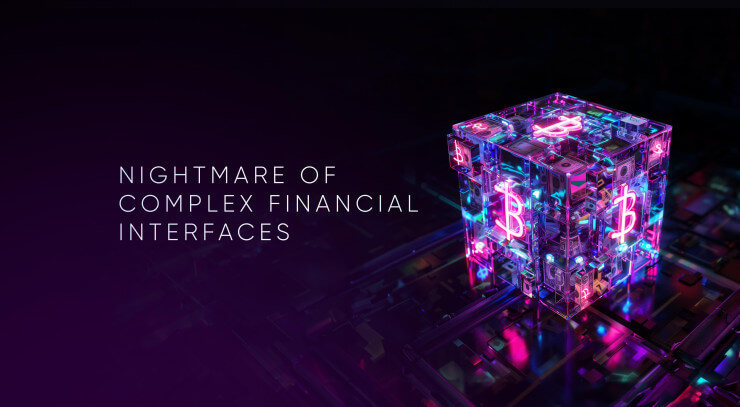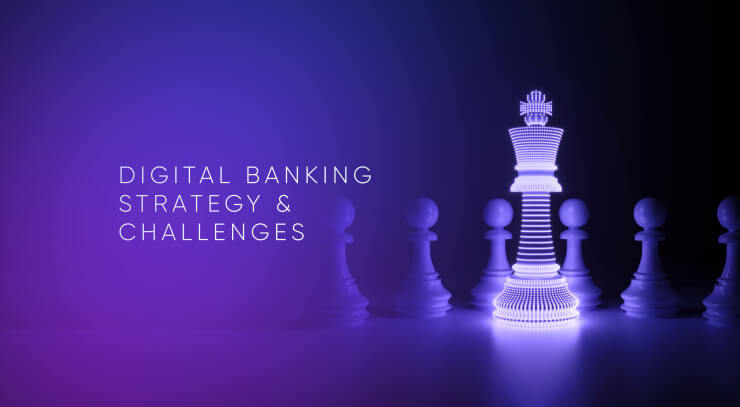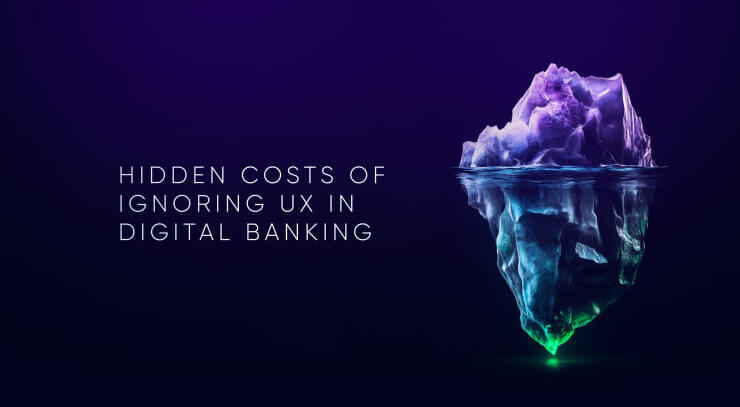The term "digital transformation" has become a buzzword in the banking sector, its popularity doubling over the past year, according to Google Trends. There are 114 million results in Google Search, and financial institutions boast about their revolutionary banking innovation approaches, their seamless integration of cutting-edge technology and their forward-thinking strategies that promise to catapult banking into the future. They envision a future in which their digital infrastructure, once modernized, will run as smoothly and steadily as their brick-and-mortar branches once did. But why do digital transformation efforts fail so often? Because it’s a comforting illusion, but it couldn’t be further from reality.
Digital transformation in banking refers to the integration of advanced banking innovations such as AI, blockchain, and cloud computing to improve efficiency, enhance customer experiences, and provide next-gen financial products. It enables banks to streamline processes, reduce costs, and offer personalized services.
Unfortunately, the failure of digital transformation initiatives is a widespread and complex issue affecting many organizations across industries. Despite significant investments in technology and innovation efforts, many companies fail to achieve the intended benefits or even see a negative return on their digital initiatives.
Failed transformations can lead to wasted resources, including time and money, without achieving the intended benefits. In many cases, projects run over budget and never deliver value. If the customer experience is disrupted or not improved by digital efforts, companies may lose market share or damage their reputation.
Companies that fail to successfully transform risk falling behind more agile competitors who can adapt more quickly to market demands and technological advancements. Frequent changes without clear direction or success can lead to employee burnout and disengagement, further hindering future transformation efforts.
Challenges Banks Face During Digital Transformation
1. High Failure Rates
Studies consistently show that a large percentage of digital transformation efforts fail to meet expectations. According to McKinsey, 70% of major business transformations fail, meaning the majority of companies do not see the anticipated return on investment (ROI) or struggle to sustain the changes.
2. Strategic Misalignment
Many organizations embark on digital transformation without a clear roadmap. Often, digital tools and platforms are adopted because they are seen as trends rather than as solutions tailored to specific business challenges. This misalignment leads to fragmented efforts that don’t connect to the organization's goals.
3. Cultural and Organizational Resistance
Changing the technology is relatively easy compared to changing the culture and mindset of an organization. People naturally resist change, especially when it comes to adopting new processes, tools, or ways of working. Without a strong change management plan, employees may become disengaged, slowing down the process or leading to failure in adoption.
4. Leadership Gaps
Successful digital transformation in banking requires visionary leadership that can drive the initiative from the top down. When leadership is not fully committed or when there’s a lack of a clear mandate, digital efforts may stall. If leaders don’t champion the change, underestimate the complexity, or fail to allocate the necessary resources (both financial and human), initiatives often lose momentum or fail to be fully implemented.
5. Technology-Centered Approach
Focusing too much on technology rather than solving real business problems can derail efforts. The transformation should be about using technology to improve processes, customer experiences, and business outcomes, not just adopting the latest trends.
6. Failing to Focus on the Customer Experience
Digital transformation efforts that don’t prioritize improving customer interactions and experiences often miss their mark. The measure of success of digital transformation in banking can be increased customer satisfaction, loyalty and engagement.
7. Inadequate Investment in Skills and Training
A transformation effort requires employees to adopt new tools and ways of working. If companies fail to invest in reskilling and upskilling their workforce, employees may struggle to keep up with new demands, leading to operational inefficiencies.
8. Lack of Agile Approach
A rigid, traditional project management approach can stifle digital transformation in banking. Digital efforts often require agility, experimentation, and adaptability. Organizations that aren’t flexible and willing to iterate often struggle to adapt to new challenges and opportunities.
9. Underestimating Complexity
Digital transformation in banking often impacts multiple departments, processes, and systems. Organizations sometimes underestimate the complexity and interdependencies involved, leading to delays, cost overruns, and incomplete implementation.
10. Fragmented Technology Landscape
Many organizations have legacy systems or a mix of incompatible technologies that hinder seamless integration and communication. This fragmented IT infrastructure can slow down progress and make transformation efforts cumbersome and expensive.
Why There is No End in Banking Transformation
Despite all the above-mentioned challenges that contribute to digital transformation failures—whether it's cultural resistance, poor strategy, or technology misalignment—the underlying issue is the misconception that digital transformation in banking is a one-time project with a fixed endpoint. In reality, the most significant struggle arises from the belief that digital transformation has a definitive conclusion, when in fact, it is an ongoing process.
Behind the shiny facade and corporate jargon lies a harsh truth: the digital transformation of the banking sector is an illusion, and the hope that modernization of any bank will ever end is a lie. The traditional banking model, characterized by physical branches, face-to-face communication and manual processes, has gone to waste. Banks must act like technology companies to ensure banking innovation, modernization and improved customer experience.
Digital transformation isn’t a destination, but a continuous evolution. The rapid pace of technological advancements, shifting customer expectations, and changing market dynamics mean that financial organizations must continuously adapt. Treating transformation as a static goal to be achieved leads to complacency and stagnation. Instead, financial companies should recognize that digital innovation in finance must become an organic, integral part of business strategy, evolving alongside the organization’s goals and the broader digital ecosystem.
The idea of “completion” is a fallacy. Success in the digital age depends on a mindset that embraces constant innovation, flexibility, and a willingness to adapt to new opportunities and challenges. Therefore, banking digital transformation is not a one-time project, but a perpetual journey that should be embedded in the financial company’s DNA for sustainable growth and competitive advantage.
The Myth of Completion
Any transformation implies a destination—a point at which a subject has fully transitioned from its archaic systems and processes into a new, future-ready state. However, in the digital banking industry, this concept is fundamentally flawed.
Technology is not static; it evolves continuously. Each new advancement spawns the need for further adaptation and integration. Banks are perpetually chasing the next big innovation in banking, whether it's cloud, blockchain, AI or quantum computing. This unending pursuit ensures that the finish line of digital transformation will perpetually recede into the horizon.
Look at the technological giants like Apple and Tesla. Their success lies in relentless innovation and regular updates that not only meet but anticipate user needs. For banks to stay relevant, they need to emulate this model. This means adopting a mindset in which digital products and services are perpetually evolving. A superficial UI (user interface) revamp or a one-off digital solution will not suffice.
Customer Expectations: An Ever-Rising Bar
Today's customers demand seamless, real-time and personalized banking experiences. Customers expect the same level of convenience, speed and personalization from their banks as they get from tech giants like Apple, Amazon or Meta.
What satisfies customers today might be deemed obsolete tomorrow. Banks must continually enhance their digital offerings to stay competitive, making the notion of a completed transformation a mirage. The race to satisfy ever-changing customer expectations requires that banking innovation and modernization efforts are in perpetual motion.
Banks must leverage advanced technologies such as artificial intelligence, machine learning, blockchain and big data analytics. This will enable banks to offer innovative banking products and services, enhance operational efficiency and deliver a superior customer experience.
Legacy Systems: The Unseen Anchors
Despite significant investments in technology, many banks still operate on decades-old legacy systems. These archaic infrastructures are deeply entrenched, forming the backbone of daily operations. The transition away from these systems is neither simple nor swift. It involves enormous costs, risks and time.
Banks often find themselves in a hybrid state, in which new digital solutions are layered on top of old systems, creating a complex and fragile ecosystem. This patchwork approach highlights that the transformation is far from complete and perhaps will never be fully realized. While you fully modernize one system, the other turns into a legacy.
Regulatory Quagmire
The banking industry is one of the most heavily regulated sectors. Every technological innovation must navigate a labyrinth of regulations, compliance requirements and security protocols.
This regulatory burden slows down the pace of transformation, forcing banks to meticulously test and validate each new system before deployment. As regulations evolve in response to emerging technologies, banks are caught in a continuous cycle of adaptation, further delaying the mythical end of digital transformation.
Cybersecurity: A Moving Target
With banking digital transformation comes the increased threat of cyberattacks. Banks are prime targets for cybercriminals, and the sophistication of these attacks grows alongside technological advancements. As banks adopt new technologies, they simultaneously open new vulnerabilities that must be secured. This relentless battle against cyber threats ensures that the banking innovation and modernization process is an ongoing effort with no definitive end in sight.
The Illusion of Innovation in Banking
Banks often trumpet their latest digital achievements as groundbreaking. However, many of these so-called innovations are incremental improvements rather than transformative changes. The marketing spin around these advancements creates an illusion of progress while the core systems and processes remain fundamentally unchanged.
Such a marketing-driven superficial approach to banking digital transformation perpetuates the cycle of financial innovation and modernization without addressing the underlying structural challenges. Financial institutions must embed a culture of continuous improvement and user-centric innovation into their core. This means adopting the mindset and agility of technology companies.
Strategic UX Approach to Banking Innovation
Why do you think the world's most advanced technology company, Apple, puts user experience (UX) at the center of its strategy and business? Apple is a paragon of perpetual innovation. Every six months, major updates redefine user expectations and market standards. To emulate technology companies, banks must embrace a culture of continuous innovation in banking, leveraging UX expertise to stay competitive.
A successful digital strategy requires embedding UX principles into the core of business operations. This involves comprehensive user research to understand customer behaviors and pain points, followed by the design of intuitive, emotionally resonant interfaces. User experience is not just about making applications look good; it's about making them intuitive, efficient and enjoyable. For example, UXDA's redesign of ITTI Digital’s core banking system reduced the bank's employee learning curve from months to hours, significantly improving productivity and customer satisfaction.
Let’s face it: digital innovation in banking is a continuous journey, not a destination. A digital banking app is not just another delivery channel; in the eyes of a modern customer, it is a bank. Therefore, constant business development means continuous improvement and updating of digital products above all else.
User-centered design (UCD) can significantly help banks adapt to continuous banking innovation and modernization required by the digital age through several key strategies:
1. Enhanced Customer Experience
By prioritizing the needs and behaviors of users, banks can design more intuitive and satisfying digital experiences. This leads to increased customer satisfaction and loyalty. UCD allows banks to create personalized banking experiences by understanding and anticipating user needs, preferences and pain points.
2. Increased Agility
UCD emphasizes iterative design and user feedback, enabling banks to quickly test and refine their digital products. This approach helps banks stay agile and responsive to changing market demands. Continuous user testing ensures that new features or updates meet user expectations and function as intended, reducing the risk of costly errors and rework.
3. Innovation-Driven Culture
By focusing on user problems and exploring various solutions, UCD fosters a culture of innovation within the bank. Teams are encouraged to think creatively to solve real user issues. UCD often involves collaboration across various departments (e.g., marketing, IT, product development), leading to more holistic and innovative financial solutions.
4. Competitive Advantage
A user-centered approach can differentiate a bank from its competitors by providing superior user experiences that attract and retain customers. By understanding user needs, banks can adopt and integrate new technologies (e.g., AI, blockchain) in ways that genuinely benefit users and improve service delivery.
5. Improved Usability and Accessibility
UCD focuses on creating simple and intuitive interfaces that enhance usability, making it easier for users of all ages and technical abilities to engage with banking services. Ensuring that digital products are accessible to all users, including those with disabilities, broadens the customer base and demonstrates social responsibility.
6. Data-Driven Decision Making
UCD involves collecting and analyzing user data to inform design decisions. This data-driven approach helps banks identify trends, understand user behavior and make informed decisions about future innovations in the financial industry. Ongoing user feedback and analytics allow banks to continuously refine and improve their digital offerings, ensuring they remain relevant and effective.
7. Regulatory Compliance and Security
UCD can help banks design educational materials and interfaces that inform users about security practices and regulatory compliance, fostering trust and reducing risk. By understanding user behavior, banks can design security features that are both robust and user-friendly, balancing security with a seamless user experience.
By adopting a user-centered UX design approach, banks can ensure they remain competitive and relevant in the digital age, continuously innovating to meet the evolving needs of their customers.
Start with understanding the customer journey and pain points through empathy mapping and user personas. Employ an iterative design process with regular user testing and feedback loops. Enhance collaboration between design, development, marketing and customer service teams. Use agile methodologies to remain flexible and responsive to user feedback and technological advancements. Regularly conduct UX research to stay updated on user needs, market trends and emerging technologies.
What are the 10 main areas of digital transformation in banking?
The main areas of digital transformation in banking can be categorized into several key focus areas where technological advancements are reshaping traditional banking processes, services, and customer experiences. Here are the primary areas:
1. Customer Experience
- Personalized Services: Leveraging data analytics, banks can offer personalized financial products and services tailored to individual customer needs, enhancing satisfaction.
- Omnichannel Experience: Providing a seamless banking experience across multiple channels (online, mobile apps, ATMs, physical branches) to ensure customers can access services anywhere, anytime.
- AI-Powered Chatbots: Implementing AI-driven chatbots and virtual assistants to provide 24/7 customer service, answer queries, and assist with transactions, improving responsiveness and convenience.
- Mobile Banking: Enhancing mobile banking apps to offer more functionality, from checking balances to applying for loans, transferring money, and managing accounts in real time.
2. Process Automation
- Robotic Process Automation (RPA): Automating repetitive, rule-based tasks such as data entry, account updates, or processing customer requests, leading to operational efficiencies and reduced errors.
- Paperless Banking: Moving away from physical paperwork to fully digital workflows, allowing faster processing of loans, mortgages, and other services.
- Streamlined Compliance: Automating regulatory reporting and compliance processes using AI and machine learning to ensure adherence to changing regulations while reducing manual work.
3. Data-Driven Decision Making
- Advanced Analytics: Utilizing big data and predictive analytics to gain insights into customer behavior, market trends, and risk management, which helps in creating better-targeted services.
- Credit Scoring and Risk Assessment: Using AI and machine learning models to enhance credit scoring accuracy and assess risks more efficiently, enabling faster and more precise lending decisions.
- Fraud Detection: Implementing AI-powered systems that continuously analyze data patterns to detect and prevent fraudulent activities in real time, enhancing security.
4. Core Banking Innovation
- Cloud Computing: Migrating core banking systems to cloud platforms for greater scalability, reduced costs, and improved speed of service delivery. Cloud computing enables better management of data and IT infrastructure.
- API-Driven Banking: Adopting open banking standards, where banks provide access to third-party developers through APIs (Application Programming Interfaces), allowing integration with fintech apps and services, fostering innovation in banking.
- Blockchain Technology: Exploring blockchain for secure, transparent, and efficient banking processes such as cross-border payments, smart contracts, and digital identity verification.
5. Digital Payments
- Real-Time Payments: Facilitating instant payments and transfers through systems like Faster Payments and other real-time payment networks, allowing customers and businesses to make payments faster.
- Contactless Payments: Supporting NFC (Near Field Communication) and mobile wallet technologies for quick, secure contactless payments, both in-store and online.
- Cryptocurrency and Digital Currencies: Some banks are beginning to integrate cryptocurrency services or exploring Central Bank Digital Currencies (CBDCs) as part of their digital payment offerings.
6. Cybersecurity and Data Privacy
- Biometric Authentication: Implementing biometric security measures like fingerprint scanning, facial recognition, and voice identification to protect customer accounts and reduce fraud.
- Enhanced Encryption: Using advanced encryption techniques to secure transactions and data transmission, ensuring confidentiality and trust.
- Zero Trust Security Models: Moving towards a "zero trust" architecture, where no user or system is trusted by default, and continuous verification is required to protect sensitive banking data.
7. AI and Machine Learning
- Predictive Insights: AI algorithms are used to predict customer needs and trends, allowing banks to offer proactive services such as pre-approved loans or investment advice.
- Customer Segmentation: AI helps in segmenting customers based on behavior and preferences, allowing banks to provide more targeted and personalized services.
- Risk Management: Machine learning models are increasingly being used to predict and mitigate financial risks, such as loan defaults, by analyzing historical data and trends.
8. Digital Lending
- Online Loan Applications: Allowing customers to apply for loans digitally, speeding up the approval process through automated credit assessments.
- Peer-to-Peer (P2P) Lending: Facilitating platforms where individuals can lend money to each other without going through traditional financial institutions, enabled by digital platforms.
- Digital Mortgages: Offering a fully digital mortgage process, from application to approval, with automated underwriting and electronic document signing.
9. Regulatory Technology (RegTech)
- Automated Compliance: Using AI and machine learning to automatically monitor regulatory changes and update internal compliance processes, reducing the cost and complexity of adhering to regulations.
- KYC and AML Automation: Automating Know Your Customer (KYC) and Anti-Money Laundering (AML) processes to verify identities, detect suspicious activities, and ensure compliance with regulatory requirements more efficiently.
10. Digital Ecosystems and Partnerships
- Collaborations with Fintechs: Partnering with fintech companies to co-develop new digital products and services, enhancing banking innovation and accelerating digital transformation.
- Banking-as-a-Service (BaaS): Banks are offering their core financial products as services that fintechs and other third parties can use to build new customer-facing applications.
- Marketplace Banking: Creating digital marketplaces where customers can access a range of financial services from third-party providers integrated into the bank’s platform.
Conclusion: Embrace the Never-Ending Story
The notion that digital transformation in banking will reach a point of completion is a comforting but misguided fantasy. In reality, the digital innovation and modernization of the banking sector is a never-ending story. Banks and financial companies must accept that continuous evolution is the new normal.
Rather than chasing the illusion of an endpoint, banks and financial organizations should focus on building adaptable, resilient systems that can evolve with the ever-changing technological landscape and constantly rising digital customer expectations.
By harnessing customer data, financial organizations can gain a deeper understanding of individual preferences and behaviors, allowing for tailored offerings and proactive service. A user-centered UX design approach ensures that FIs can continuously refine and enhance the digital customer journey.
Banks and financial companies that embark on the path of continuous development of their digital ecosystem achieve incredible results. Both external and internal growth are activated, culture changes, efficiency increases, business processes are optimized and innovative opportunities appear─all of this leading to an increase in the number of customers, profits and market share.
For example, in just two years, the Emirates NBD digital team, in collaboration with UXDA, updated the bank’s digital ecosystem, implemented the principles of a user-centered design approach and introduced a range of banking innovations, thus transforming the renowned UAE banking brand into a leading provider of digital retail banking services for the mass market.
Embracing this mindset will not only prepare banks and financial companies for the future but also ensure they remain agile and competitive in a world where change is the only constant. The journey of banking digital transformation is real but it will never end, and financial organizations must navigate it with eyes wide open, prepared for infinite banking innovation.
Get UXDA Research-Based White Paper "How to Win the Hearts of Digital Customers":
 If you want to create next-gen financial products to receive an exceptional competitive advantage in the digital age, contact us! With the power of financial UX design, we can help you turn your business into a beloved financial brand with a strong emotional connection with your clients, resulting in success, demand, and long-term customer loyalty.
If you want to create next-gen financial products to receive an exceptional competitive advantage in the digital age, contact us! With the power of financial UX design, we can help you turn your business into a beloved financial brand with a strong emotional connection with your clients, resulting in success, demand, and long-term customer loyalty.
- E-mail us at info@theuxda.com
- Chat with us in Whatsapp
- Send a direct message to UXDA's CEO Alex Kreger on Linkedin






















